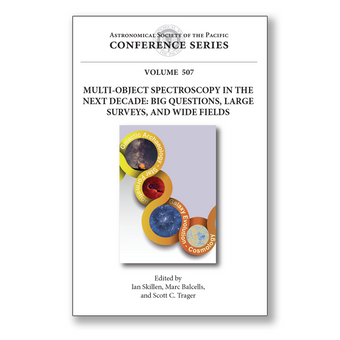Vol. 507 – Multi-Object Spectroscopy in the Next Decade: Big Questions, Large Surveys, and Wide Fields
Your purchase of this volume includes a printed copy and electronic access. With your purchase of this title online, you will receive email instructions on how to access the e-Book version. If you wish to use our printable order form and mail or fax it to us, you will need to include your email address on this form in order to receive electronic access to the purchased volume(s).
Volume CS-507
Editor(s): Skillen, I.; Balcells, M.; Trager, S. C.
Print ISBN: 978-1-58381-898-5
e-Book ISBN: 978-1-58381-899-2
Published: 2016
Teatro Circo de Marte, Santa Cruz de La Palma Canary Islands, Spain 2–6 March 2015
Large-scale spectroscopic surveys are essential to resolve some of the most profound questions confronting astronomers: How can the fossil record reveal the assembly history of the Milky Way? How do galaxies form and evolve? What is the nature and distribution of dark matter? Why is the expansion of the universe accelerating?
Several ambitious multi-object spectrographs are in rapid development around the world, and in March 2015 the Isaac Newton Group invited the international community to a conference held in La Palma, Canary Islands, to bring together scientists who have played vital roles in developing and exploiting past generations of survey spectrographs and those planning the next-generation instruments and surveys. The aim was to encourage the exchange of experience and expertise, and to develop coherent strategies among the large survey teams.
The conference attracted 149 delegates from 21 countries, and topics presented covered Galactic structure and archaeology, stellar evolution, galaxy evolution, cosmology, and new, state-of-the-art instruments. It concluded with a fruitful discussion on the challenges of developing, operating, and exploiting these new instruments and their surveys, and the opportunities enabled by anticipated advances in technology.
The papers in this volume provide an overview of the role and future directions of spectroscopic-survey science. As a record of the insights and aspirations of recognized world leaders in the field, it will be a valuable reference to multi-object spectroscopy for a considerable time to come. It will be of interest to students, astronomers, instrument builders, and funding agencies, as new instruments and surveys are conceived in the coming years.
For more information about this publication and other ASP Conference Series Proceedings, click here (a new browser window will open).


